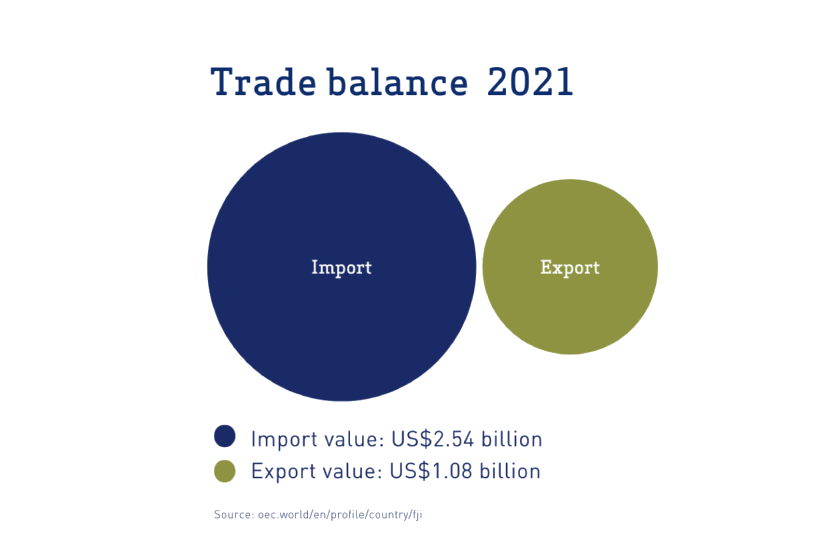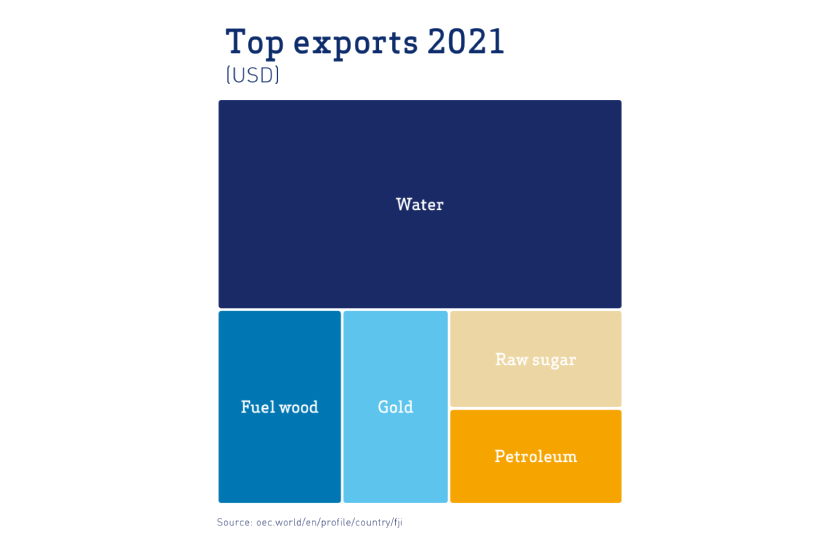- In 2021, Fiji exported $1.08 billion worth of goods and services, versus $2.54 billion in imports.
- That export value is highly concentrated to few sectors.
- IPA Group Executive Advocacy and Policy Vicki Stylianou recently travelled to Fiji to present at the Fiji Institute of Chartered Accountants 2023 Congress, sharing practical insights to help local businesses build export capacity.
- Here, we recap the need for that capacity-building and the tactics local businesses can use.
Trade imbalance
Fiji imported US$2.54 billion worth of goods in 2021, and exported US$1.08 billion, mostly to the United States, Australian China, New Zealand and Tonga.

Top exports
While the list of top exports for the small nation does show industry and sector variation, export value and contribution to GDP is highly concentrated at the top of the list.

- Water: $258 million
- Fuel wood: $73 million
- Gold: $63.2 million
- Raw sugar: $52.1 million
- Refined petroleum: $49.8 million
The concentration of Fiji’s export market is mirrored in the economy overall, with tourism contributing $1.34 billion to GDP in 2019.
This is more than the entire export value of other products and services.
Barriers to export
While barriers are not insurmountable, they do require expertise to resolve – particularly expertise in forecasting, risk mitigation and cash flow management. Accounting professionals are well placed to partner with their clients to identify the highest value opportunities and resolve challenges.
Those challenges include:
- Resource constraints that limit their ability to invest in market research, product adaptation, international marketing and the development of distribution channels
- A lack of export knowledge that would help them navigate regulatory and cultural complexities
- New risks including compliance, longer and more complex supply chains, currency fluctuations, political instability, trade barriers and legal disputes
- Cash flow pressure from increased shipping, logistics, marketing and insurance costs; fluctuating exchange rates; and difficulty securing favourable payment terms from international buyers
10 actions to support export development
To tap into export opportunities successfully, businesses could consider:
- Market research: Thorough market research enables small businesses to identify viable export opportunities, make informed decisions, and tailor products or services to meet the needs of target markets. This includes assessing market demand, competition, cultural preferences and regulatory requirements.
- Seek export assistance: Governments and trade promotion organisations may provide resources, training, market intelligence and networking opportunities.
- Develop a strategic export plan: Outline objectives, target markets, marketing strategies, distribution channels and resource allocation, as a roadmap for export activities that enables focus and prioritisation.
- Build partnerships and networks: Collaborate with distributors, agents or partners in the target market who offer local market knowledge, established networks and distribution channels.
- Attend trade shows and exhibitions: Showcase products or services to generate leads, network with potential buyers to build relationships, and gain market exposure to understand trends.
- Access export financing and insurance: Trade loans, export credit insurance or government-backed export financing programs can help address working capital needs, manage cash flow and mitigate risk.
- Develop competitive advantages: Develop and communicate unique value propositions or niche products – superior quality, customisation, innovation, sustainability or competitive pricing.
- Persistence and adaptability: Prepare for setbacks and learn from experience. Continually monitor market conditions, seek feedback from customers, and be open to adjusting to stay competitive and seize emerging opportunities.
- Leverage e-commerce and digital platforms: Social media, e-commerce marketplaces and digital advertising can help small businesses overcome geographical barriers and access global markets.
- Build export knowledge and skills: Attend export training programs, workshops or online courses that cover export documentation, logistics, cultural intelligence, negotiation skills and international marketing.
Government policy and action must facilitate trade and investment, for example by establishing consistent standards, institutional frameworks and measures to improve market openness, and by negotiating bilateral, regional and other trade agreements.
At the same time, accounting professionals can help to increase export levels by identifying and partnering with clients that are export-ready or by identifying one way an already-exporting business can improve.


